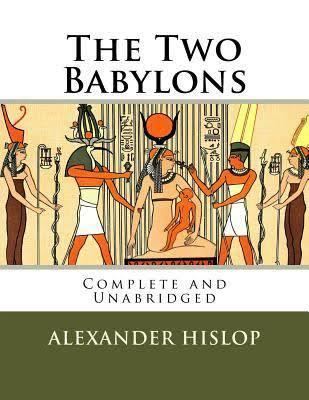Originally published 1858 | ||
 | ||
Similar Alexander Hislop books, Catholic Church books | ||
The Two Babylons, subtitled The Papal Worship Proved to Be the Worship of Nimrod and His Wife is a religious pamphlet published in 1853 by the Presbyterian Free Church of Scotland theologian Alexander Hislop (1807–65). It was expanded in 1858, going through many editions. A 3rd edition was published in 1862, a 7th in 1871, a popular edition in 1903. It has been claimed on many websites that The Two Babylons was only finally published as a book in 1919, though the third edition reached 500 pages in length.
Its central theme is its allegation that the Catholic Church is a veiled continuation of the pagan religion of Babylon, a product of a millennia-old conspiracy.
Argument
Hislop builds on the Panbabylonian school of Hyperdiffusionism, which was common in the 19th century, to argue that Classical and Ancient Near Eastern civilization took all its inspiration from Babylon, and from that he derived the argument Mystery Religions of Late Antiquity were actually offshoots of one ancient religion founded at the Tower of Babel. Panbabylonism has since been relegated to pseudohistory.
Much of Hislop's work centers on his association of the legendary Ninus and his semi-historical wife Semiramis with the Biblical Nimrod. Hellenistic histories of the Ancient Near East tended to conflate their faint recollections of the deeds of ancient kings into legendary figures who exerted far more power than any ancient king ever did. In Assyria, they invented an eponymous founder of Nineveh named Ninus, who supposedly ruled 52 years over an empire comparable to the Persian Empire at its greatest extent. Ninus's wife Semiramis was in turn a corruption of the historical figure Shammuramat, regent of the Neo-Assyrian Empire from 811 BC. Hislop takes Ninus as a historical figure, and associates him with the Biblical figure Nimrod, though he was not the first to do so. The Clementine Literature made the association in the 4th Century AD. An influential belief throughout the Middle Ages was that Ninus was the inventor of Idolatry, a concept that Hislop clearly drew upon. However, Hislop wrote before the historical records of the ancient near east had been thoroughly decoded and studied, and it became apparent in the decades after he wrote that there never was any such figure as Ninus, and that the Greek authors whom he quotes were without credibility on the subject.
The Two Babylons heavily relies on Austen Henry Layard's publications of his excavations at Nineveh, which had only been just discovered in 1851. This gave his work an appearance of being well-researched at the time of its publication. For example, Hislop linked the name of Easter with Astarte, the Phoenician fertility goddess by citing Layard's recent discovery of Astarte's Assyrian name, Ishtar, which Hislop took to be "identical" to Easter.
What means the term Easter itself? It is not a Christian name. It bears its Chaldean origin on its very forehead. Easter is nothing else than Astarte, one of the titles of Beltis, the queen of heaven, whose name, as pronounced by the people Nineveh, was evidently identical with that now in common use in this country. That name, as found by Layard on the Assyrian monuments, is Ishtar.
Modern Etymologists derive Easter from the Proto-Indo-European root *aus-, meaning "dawn," potentially by way of *h₂ewsṓs. Ishtar is a Semitic name of uncertain etymology, possibly taken from the same root as Assyria, or from a semitic word meaning "to irrigate."
Hislop ultimately traces Catholic doctrines back to the worship of Nimrod, claiming that the Roman Catholic Church is the Whore of Babylon in the Bible Book of Revelation 17:5, and that "the Pope himself is truly and properly the lineal representative of Belshazzar". He claims that the Christogram IHS, the first three Greek letters in the name of Jesus, are really Latin characters standing for Isis, Horus, Seth.
In the note by the editor of the 7th edition, which was published in 1871, it was claimed, "that no one, so far as we are aware, has ventured to challenge the accuracy of the historical proofs adduced in support of the startling announcement on the title page." Since then however there have been many who have challenged the accuracy of Hislop's claims. Scholar Lester L. Grabbe has highlighted the picture presented by Hislop, that Nimrod is equated with Ninus is based on a misunderstanding of historical Babylon and its religion, however his book remains popular among some fundamentalist Protestant Christians and among Jehovah's Witnesses, with The Watchtower frequently publishing excerpts from Hislop until the 1980s.
Although extensively footnoted, some commentators (in particular Ralph Woodrow) have stated that there are numerous misconceptions, fabrications and grave factual errors in the document.
In 2011 a critical edition was published which also contains the English book by Ralph Woodrow as well as the papers by Ralph Woodrow and Dr. Eddy Lanz.
The book's thesis has also featured prominently in the conspiracy theories of racist groups such as The Covenant, The Sword, and the Arm of the Lord and other conspiracy theorists.
